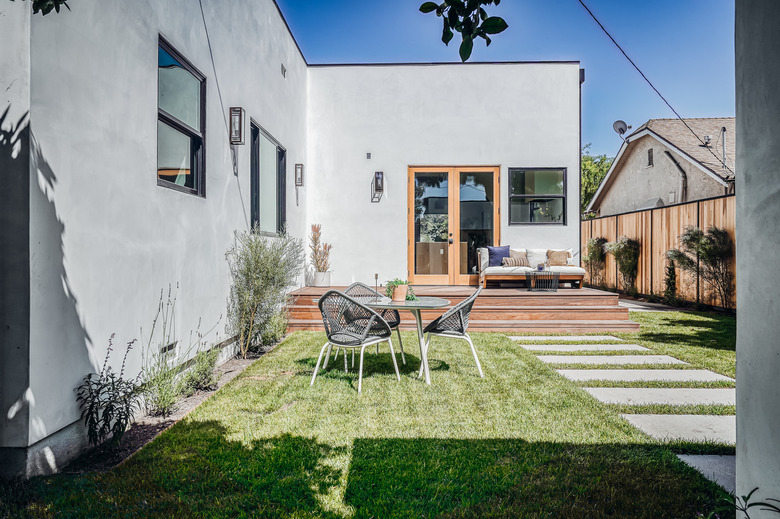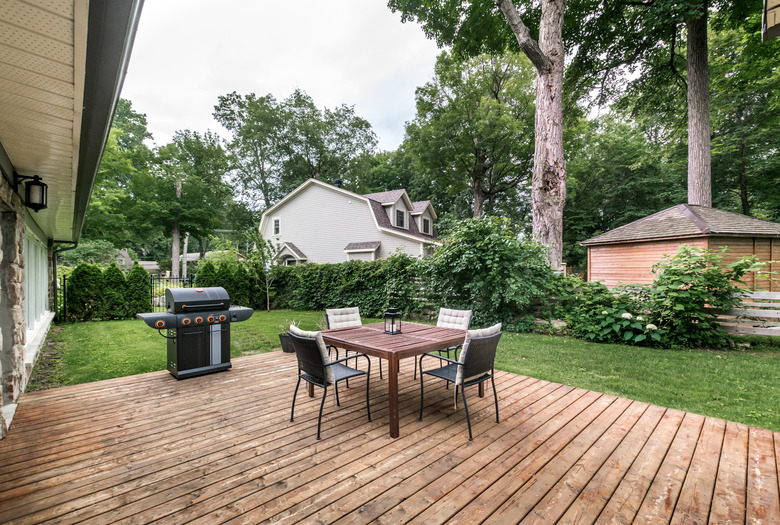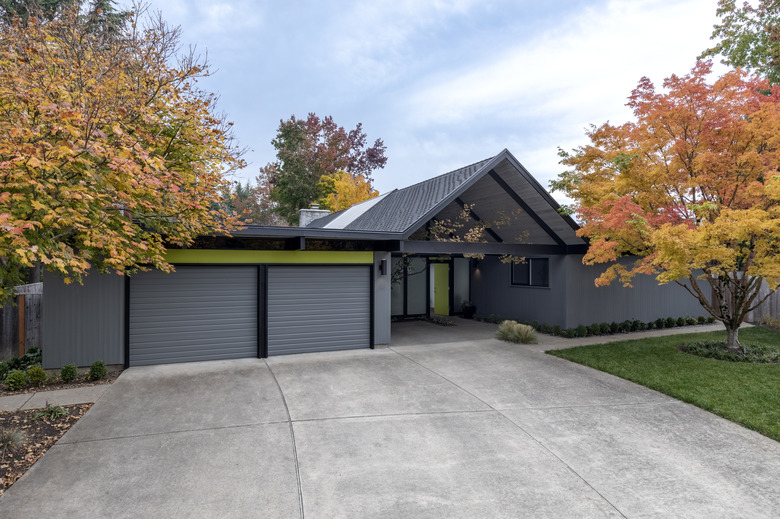Yard Drainage Problems And Solutions: A DIY Guide
We may receive a commission on purchases made from links.
Every landscape design includes a detailed plan for yard drainage because simply allowing water to flow wherever it wants can create a number of potentially disastrous problems, including erosion, standing water and water-clogged soil that is unfit for planting. Poor yard drainage can also cause water to collect around the foundation of your house and seep into the basement, where it can cause expensive issues such as flooding, structural damage or both.
Yard drainage problems can be the result of topography and a mixture of soil types as well as improper placement of gutter downspouts, installation of nonpermeable patios and driveways and poor grading. Some of the more common problems have fairly simple DIY solutions, but some call for professional help because it's easy for an inexperienced landscaper to create a new problem when tackling an existing one. Two natural forces — the relentless pull of gravity and the uncanny ability of water to find the path of least resistance to the lowest point — underlie all drainage problems, and to solve them, you have to think like water.
Characteristics of a Well-Draining Property
Characteristics of a Well-Draining Property
Before a house is built, the land is typically graded to direct water runoff away from the foundation. Ideally, the land descends at least 6 inches over a 10-foot distance from the house and another 12 inches over the next 100 feet. Few properties are ideal, however, and undulations in the land may force water to flow toward the house. In this case, the foundation construction includes an effective perimeter drainage system.
Water that flows away from the house continues on its downward course until it either soaks into the ground or runs off the property. In most cases, this runoff is unnoticeable, but if the land is hilly, small streams or rivers can form, and these can turn into torrents during heavy rains. These torrents may occur only occasionally, but each time one does, it can wreak havoc.
When the features creating these streams are natural, nature usually also provides escape routes for the water, and builders avoid constructing anything on these routes. The causes aren't always natural, though. They could be hardscaping items such as retaining walls, walkways or small buildings that alter the direction in which stormwater flows, thus creating new drainage issues to solve.
Water Around the Foundation
Water Around the Foundation
Even if the property was properly graded before the house was built, water can collect around the foundation for a number of reasons. The eaves may be flooding over, the downspouts may be too close to the house or a new patio may be shedding water that previously soaked into the ground. Michael Hatcher & Associates recommends regrading to clear water from the foundation, but that's a big job that may require a contractor with heavy equipment, depending on the size of the house. Even regrading with hand tools can disrupt the landscape, and it isn't always necessary.
If the ground around the foundation is soggy, the gutters are the most likely source of the excess water. If it has been a while since you cleaned them, now is the time to do it again, paying special attention to the downspout inlets and clearing them of leaves and other obstructions. Extend the downspout outlets with corrugated drain pipe long enough to ensure water flows away from the house or, if necessary, dig a small dry well for each downspout outlet so water can seep into the ground.
Runoff From Patios and Driveways
Runoff From Patios and Driveways
The sogginess around the foundation may be runoff from a patio or walkway, and you may be able to handle that by digging a swale, which is a wide, shallow rock-filled or grass-filled trench that slopes away from the house. Another solution is to construct a French drain, which you do by digging a sloped trench, laying perforated pipe over a bed of gravel and covering it with gravel followed by topsoil. Connecting the French drain system to grid-covered catch basins located where water tends to pool improves the efficiency of the system and offers more protection to the home's foundation.
Swales are a common way to handle runoff from the driveway. They can be filled with stones or covered with turf, and either way, they work by allowing the water that flows off the pavement to soak into the ground. In places that get a lot of rain, a swale provides an ideal location for a rain garden filled with water-loving plants.
Yard Drainage for Standing Water
Yard Drainage for Standing Water
When a small lake forms in your yard every time it rains, it's usually due to a combination of topography and poor soil. Standing water creates what Warner Service calls water-clogged soil — soil so saturated it can't handle any more water — which would be disastrous if the flooded section is part of a septic drainfield. Fortunately, that's unlikely since a drainfield must be located on well-draining soil to be permitted by the local heath authorities.
Often, the best way to handle standing surface water is to regrade the ground and perhaps bring in extra dirt to build up the low spot. If the water covers a large area, this is another job for a contractor, but if the area is fairly small and you want to do something yourself, consider these drainage solutions:
- Dig a swale with a downward slope to a runoff point or a dry well on your property. Do not direct the water to a neighboring property unless you have worked out a plan with the neighbor. Draining water onto a neighbor's property is an unneighborly thing to do, and it's even illegal in some communities.
- Install a French drain system that directs the water to a dry well or a suitable runoff point.
- Improve soil that has a high clay content to make it more porous and water-absorbent. To do this, Gardening Know How recommends turning organic matter such as compost into the soil and then covering the area with organic mulch. If you plant a cover crop such as borage or clover, the roots will aerate the soil, and when the growing season is finished, you can turn the crop into the soil to increase the concentration of organic material as further insurance against clogging.
Handling Erosion Problems
Handling Erosion Problems
Flowing water can create as many drainage issues and cause as much damage as standing water. It can shift topsoil and create ever-deepening ruts that make the ground unsuitable for planting or building. Strategies for countering erosion usually focus on slowing down the water flow and diverting it:
- Terrace a steep slope to slow down stormwater surges and change the direction the water flows while giving yourself the opportunity to plant flower beds or construct rock gardens.
- Build a retaining wall to protect existing shrubs, flower beds or hardscape features. A retaining wall usually has an underground drain pipe on the uphill side to catch water and direct it to a more suitable location.
Constructing a dry creek bed that follows the path of the water neither slows down nor redirects the water flow, but it prevents further damage to the landscape. A dry creek bed is a trench lined with landscape fabric, bordered by large river rocks and filled with smaller ones. It's an attractive feature to add to any landscape, especially in semiarid places prone to the occasional washout.


